The Battle of Cambrai: 'We had a sense of victory for the first time'
- Published
The ravaged remains of the tank "Deborah", which fought at Cambrai, were found in 1998
After years of tiny gains at the cost of appalling casualties, Cambrai, fought 100 years ago, was heralded as the longed-for victory on the Western Front. But did a battle that left both sides almost where they started really change the course of the war?
L/Cpl Alfred Brisco recalled in the aftermath of the fighting that his battle, inside the tank "Hotspur", came to a sudden and violent end: "There was a terrific roar and Hotspur shuddered from stem to stern.
"I saw our left caterpillar track fly in the air. Our left nose was blown off. If that last shell had landed two feet closer the officer and I would most certainly have both been killed."
Other crews nearby were not so lucky.
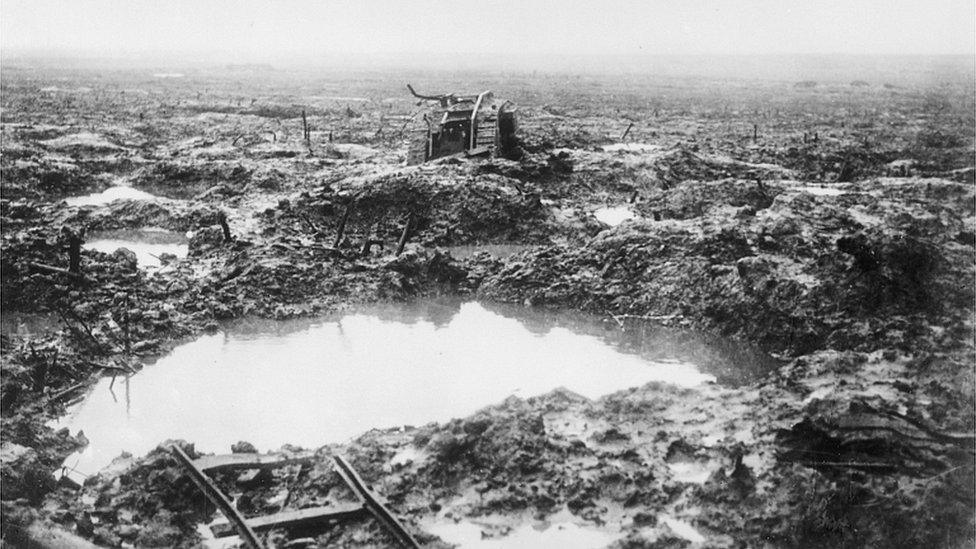
Tanks had not lived up to expectations at Passchendaele, with many sinking into the mud
"A tank close to our right received a direct hit and burst into flames. I only saw one man roll out of a side door," Brisco said.
"The tank on our left also had a direct hit. I did not see anyone get out of that."
It was a terrible end to what had actually been a day of great progress for the British, who advanced further in six hours than in three months at Passchendaele, external.
After months of planning, the largest tank force so far assembled in the war - nearly 480 machines in all - had on 20 November smashed a seven-mile wide, four-mile deep hole in the Germans' toughest defences near the French town of Cambrai, just 25 miles from the Belgian border.

German defences - called the Hindenburg Line by the British - featured belts of wire 50ft deep
"It was a stunning success," said Bryn Hammond, head of collections at the Imperial War Museum, external. "For the first time since the war had begun, the church bells were allowed to ring."
Tanks, first used only 14 months before, were still distrusted by many.
They had struggled in the mud of Passchendaele and were hellish places in which to serve.
Lt Kenneth Wootton, of the Tank Corps, wrote in his account of the war: "The noise inside was absolutely deafening; the eight-cylinder engine was going at full speed, both six-pounder guns were firing as rapidly as possible and I was emptying drum after drum from the machine-gun.
"Any order I gave to the driver, who was close beside me, had to be shouted in his ear.... everything else had to be done by signs."

Tank used fascines - bundles of wood - to help cross the extra-wide trenches built at Cambrai
But this battle was different.
Dr Hammond said: "The key was surprise.
"There had been no week-long artillery bombardment; everything had been brought up in secrecy.
"And it was an integrated battle plan: tanks, infantry, artillery and aircraft all had a specific role to play."
Supporting the tanks were 1,000 artillery pieces, 110,000 infantry and 300 aircraft.
Belts of wire 50ft thick, which would have taken weeks to cut through in a traditional attack, were crushed by the tanks.

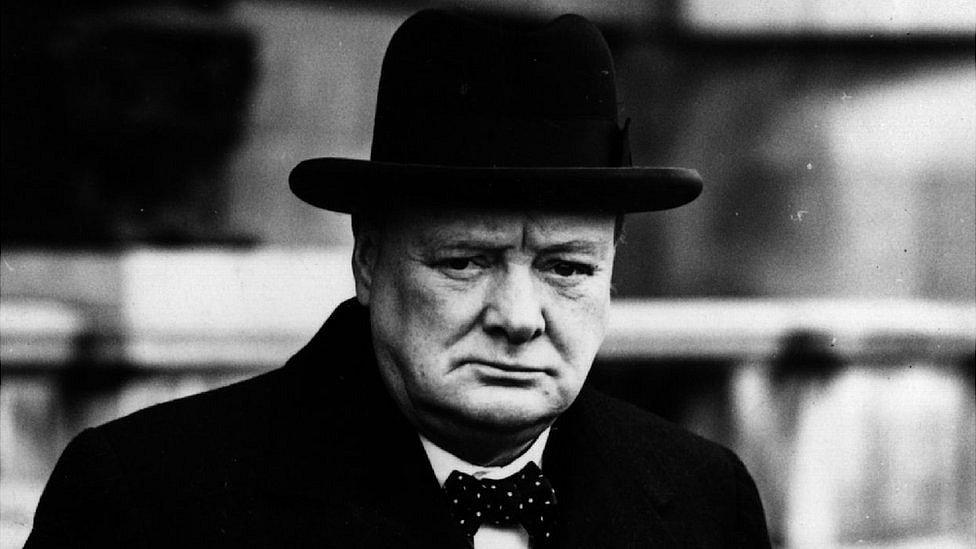
Accusing as I do without exception all the great Allied offensives of 1915, 1916, and 1917 as needless and wrongly conceived operations of infinite cost, I am bound to reply to the question, 'What else could have been done?' And I answer it, pointing to the Battle of Cambrai: 'This could have been done.'
Winston Churchill

Men and armour poured through the gaps. German defenders were overwhelmed. Soldiers described the advance as "a picnic" and "a cakewalk".
Commanders were left giddy by the success.
In his memoirs, Maj Richard Foot, of the Royal Field Artillery, said: "That first day was a day to be remembered. We really had the sense of victory for the first time."
But there was still savage fighting, as another officer, Maj William Watson, recalled finding in nearby trenches.
"The trench-boards were slippery with blood and 15 to 20 corpses, all Germans and all bayoneted, lay strewn about the road like drunken men.
"A Highland sergeant... who was in charge of the place, came out to greet us puffing a long cigar."
But the punch of the first hours, which had taken months of planning and resources, could not be maintained.
Tanks broke down, men became exhausted.

Deborah - The lost tank of Flesquieres
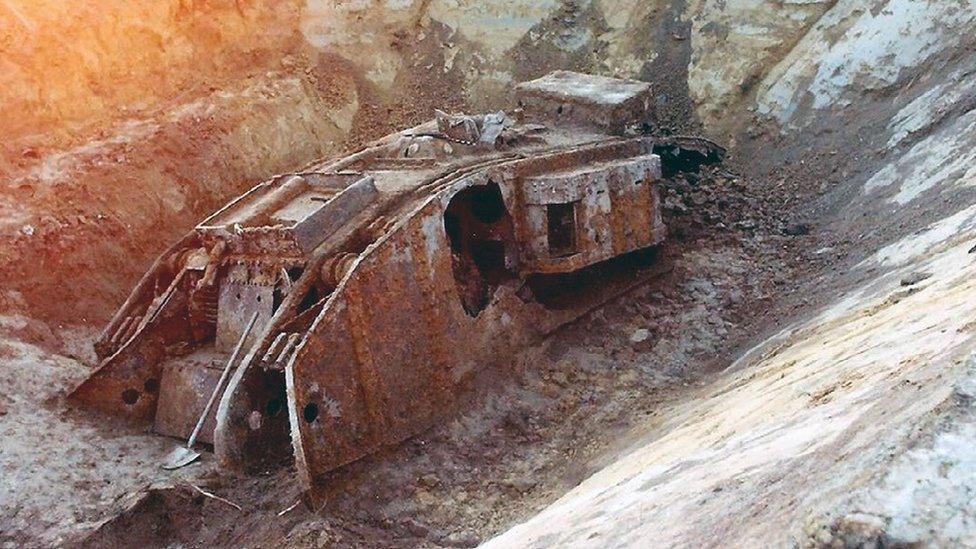
Deborah was finally found in 1998
A six-year "obsession" led one man to uncover one of the most striking and poignant reminders of the Battle of Cambrai.
A tank named Deborah had made it through the village of Flesquieres but was one of nearly 40 that were destroyed as the tide of the battle turned.
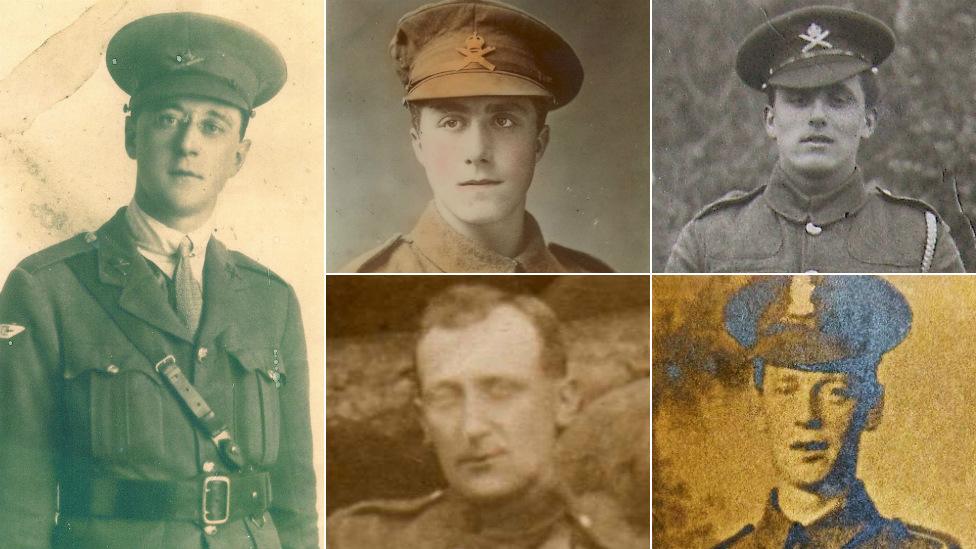
Clockwise from left: Frank Heap survived (along with two unknown crew) while George Foot, Joseph Cheverton, William Galway and Fred Tipping all died
Cambrai resident Philippe Gorczynski said: "An old woman told me about a tank being buried in the village after the war, and I just had to find it.
"I looked everywhere, I went 'hunting' in the woods and 'fishing' in the lakes - my wife said she had to share me with another woman!
"I looked at hundreds of aerial photographs and these, along with ground-penetrating scans, showed us where to go.
"The day we found Deborah was like finding the Grail. Here was an emblem of the battle, a tribute to all the men who served."
Historian John Taylor researched the crew and found the commander Frank Heap, 20, from Blackpool, had survived and won the Military Cross.
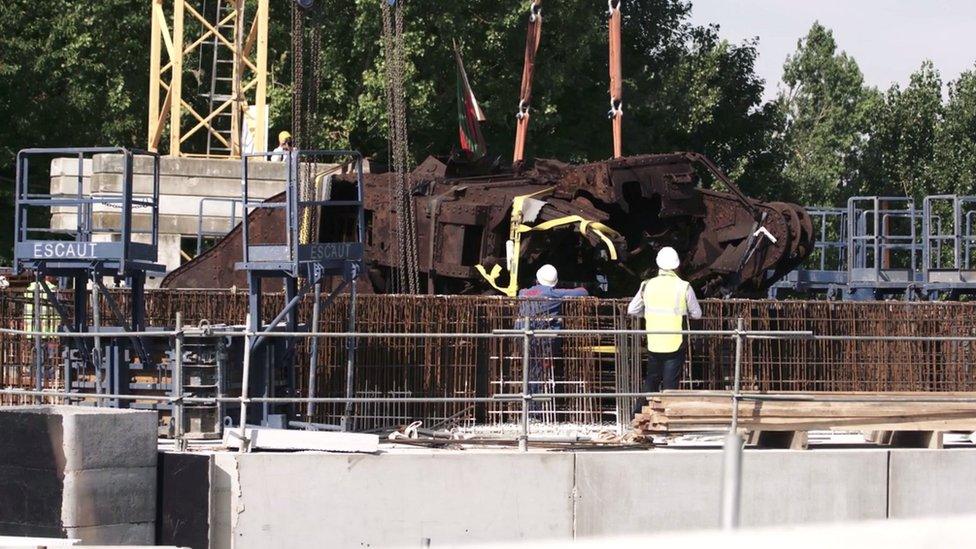
Deborah being lifted into her new home at the "Cambrai Tank Museum 1917"
But George Foot, 20, from north London, William Galway, 25, from Belfast, Joseph Cheverton, 20, from Cambridge, and father-of-three Fred Tipping, 36, from Nottingham, all died in the flaming wreck.
Mr Taylor said: "It is important to remember these were men from typical towns, who fought in terrible circumstances but achieved remarkable things."
Deborah is now the centrepiece of a museum that will open to mark the 100th anniversary of the battle.

Dr Hammond said that after the Germans - who had no tanks of their own - had got over the "initial shock", they fought back bravely, "almost hand to hand".
"Bundled grenades were thrown under tracks, rifles fired through vision slits, even guns physically held down so they would fire into the ground - it got that close."
Another week of fighting hardly moved the front lines but cost thousands more men.
The British army, exhausted by Passchendaele, simply did not have enough soldiers, guns and tanks to exploit the gap in the defences.
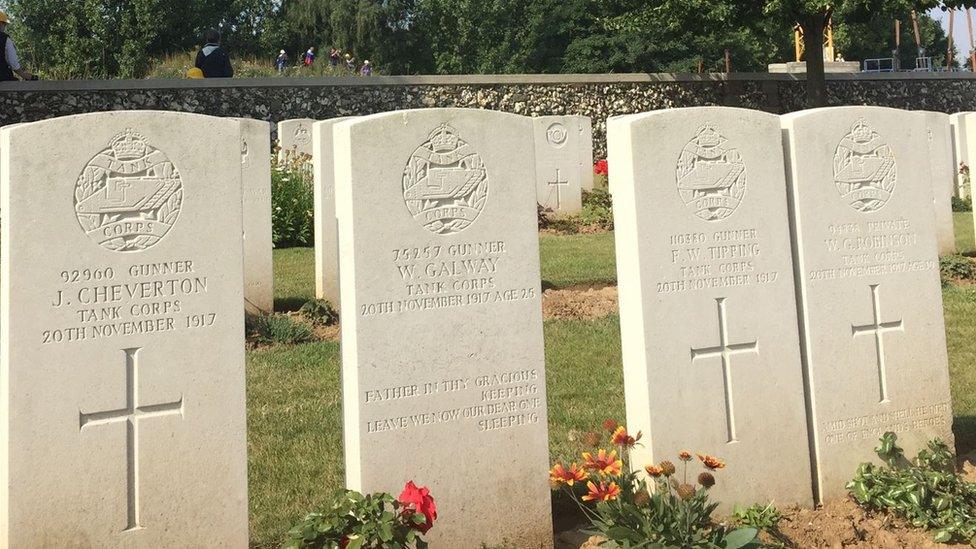
Flesquieres Hill British Cemetery is the final resting place of hundreds of the dead from the battle - including men who served in Deborah
Then on 30 November the Germans, backed by flamethrowers, counterattacked.
By 7 December, the armies held roughly the same amount of ground they had started with.
The British army had suffered more than 44,000 casualties, with nearly 180 tanks destroyed. The Germans had lost a similar number of men.
Had it all been for nothing?

The huge tank attack carved a way through the defences for the infantry to exploit
Dr Hammond said: "The attack did not realise its potential due to lack of support, but these were the tactics which shattered German defences on the Western Front in 1918.
"It was a landmark in warfare. It establishes the principle of surprise attack, using each weapon in the role for which it is best suited, still used in the Gulf War.
"The era where the deadly combination of machine-guns, barbed wire, artillery and trenches defined the character of the battlefield was over."
- Published31 July 2017
- Published21 July 2017

- Published15 September 2016
